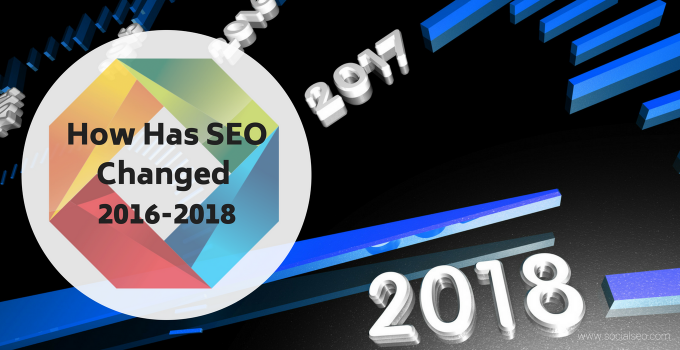In a previous blog post, we went over the basics of content optimization – what…

2 Years of SEO Evolution: Safeguarding Future Success
Stephen Jay Gould once said: “Evolution is a process of constant branching and expansion.”
While Gould may not have spoken in the context of industrialism or commercialism, he was right nonetheless — particularly in regard to SEO and other digital marketing services.
Today’s businesses need an active, current, and engaging website in order to more effectively reach their professional goals and fulfill their ultimate mission.
But to draw organic visitors to their websites, businesses must have insight and awareness of not only who their customers and prospects are, and what they need, but what products and/or services their business can provide. By researching previous patterns of possible leads, businesses can potentially predict the evolution of future SEO trends, thereby helping to safeguard their future success.
For example, businesses can achieve their goals for expansion and profit with E-Commerce SEO. This strategy uses hundreds of different keyword phrases with hundreds of unique categories and landing pages. Organic visitors are not just surfing the web — they’re ready to buy, so SEO is crucial.
Businesses need to find relevant topics and themes to structure their content around, and then use that information to learn more about the needs and interests of their audience. With that information, a business’s SEO strategy would efficiently pave the way for a significant increase in revenue and overall growth.
Businesses can develop effective strategies once they identify patterns, and answer the questions: “What do people need?” and “What are people looking for?”
In the past two years, SEO has evolved dramatically. But while two years doesn’t seem like a long period of time to some people, a lot can certainly change.
In 2016, over 90% of the population used the internet and online resources to search for what they needed and/or wanted.
But how has SEO changed since then? Is keyword research different? Have the metrics of Google’s algorithm changed?
The fundamentals of keyword research have not changed. Google’s keyword research tools such as Google’s Keyword Planner, Ubersuggest, SEMrush, and Searchmetrics Keyword Analysis Tool are still relevant and helpful today as they were two years ago. Reviewing website analytics for keywords and researching the keywords of competitors are still good SEO strategies. As Google Premier Partners, certified in search, video, display, mobile, shopping, analytics, and more, SocialSEO knows the importance of building revenue with PPC using Google AdWords.

For starters, in 2016 the top-ranked SEO websites had:
- a word count between 1,140-1,285
- keywords in the content, header, title, subheader, introductory paragraph, and a conclusion paragraph
- meta-descriptions and H1 tags
- quick loading times of 1.16 seconds (PC) and 1.10 seconds (mobile)
- optimization of each content piece
- proper content structure including menus, buttons, bullets, internal links and external links
- fewer ads
National SEO is a long-term investment that sets companies apart from their competitors. By first identifying their overall goals, a business can move to the second step by performing a keyword analysis to determine which words make the most sense for their company as well as identify the phrases most often used by consumers.
In 2017, SEO took a turn and began to head in a new direction.
Mobile content took precedence in search engine crawling and ranking, leaving everything to basic SEO practices such as:
- targeting fewer derivations of keywords. Rankbrain began to impact rankings by recognizing abbreviations, acronyms, plurals, synonyms, and answers.
- forgetting algorithms, and just following consumer behavior. People were drawn more toward videos and images and avoided bulky text.
- using Google as a bellwether.
- focusing on UX. Rankbrain and machine learning got much smarter. SEO and UX needed to merge as search engines rewarded sites with exceptional customer experience and fast load times. Over-optimized sites based on keywords lost to great UX.
- clarifying intent. No longer was SEO about certain keywords as it was about clarifying intent. Cross-channel marketing affected the SEO viability on business pages.
- hiring ethical SEO specialists. Buying links and over-optimizing keywords was no longer an option for users.
- improving site-speed and limiting errors.
- shifting to mobile first indexing. The mobile UX and mobile search intent became increasingly important.
- having quality backlinks. In the past, it was all about quantity, but then suddenly brands had to ensure their backlinks came from high-quality sources.
- moving from content production to a content library. Previously, content frequency, recency, and relevance were used for ranking, but that changed. Content required thorough research and multi-media organization with great value.
Fortune 1000 or Global 2000 companies use Enterprise SEO, a strategy that fixates more on the number of pages a website has (specifically for products and services) and less on the overall company size. The primary focus of these types of companies is organic keyword searches.
But as a new year approaches SEO trends show:
- Video and image searches will increase. Online interactions have become more visual, and with faster internet speeds, and more visual friendly social media platforms, the general public desires to engage with images and videos.
- Knowledge graphs will dominate. Featured snippets (or the concise answers to questions user’s pose in search queries) will be replaced with knowledge graphs so as to provide better, consistent answers.
- Voice searches will increase with smart speaker sales. Amazon Echo and Google Home are voice activated speakers and provide spoken search results, allowing the user to simply use their voice and ears.
- Individual customization will change how rankings are calculated. Relying on individual search histories, browser cookies, and other info provides better, personalized SERP’s for individuals, but simultaneously makes it difficult to know how companies will rank and for what.
- Machine learning will be the end of search algorithm updates. Businesses will see a greater influence of machine learning over typical search results. Algorithm updates will fade away in favor of automated, continuous, and iterative algorithm updating processes carried out by machine learning.
- SEO will expand beyond Google and Bing. Yelp, Amazon, and Siri are relevant search engines in their own right. So in the future, businesses will have to think beyond Google’s range of influence.
- Hyperlocal results will finally take off. With a Local SEO strategy, businesses can reach their friends and neighbors more easily and efficiently than ever before, thereby increasing revenue they may have otherwise missed.
Don’t delay implementing SEO, SEM and/or other digital marketing strategies into your business operations. Contact our Digital Strategy Experts, and watch your business grow and your revenue expand.



